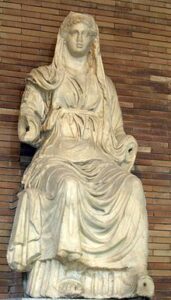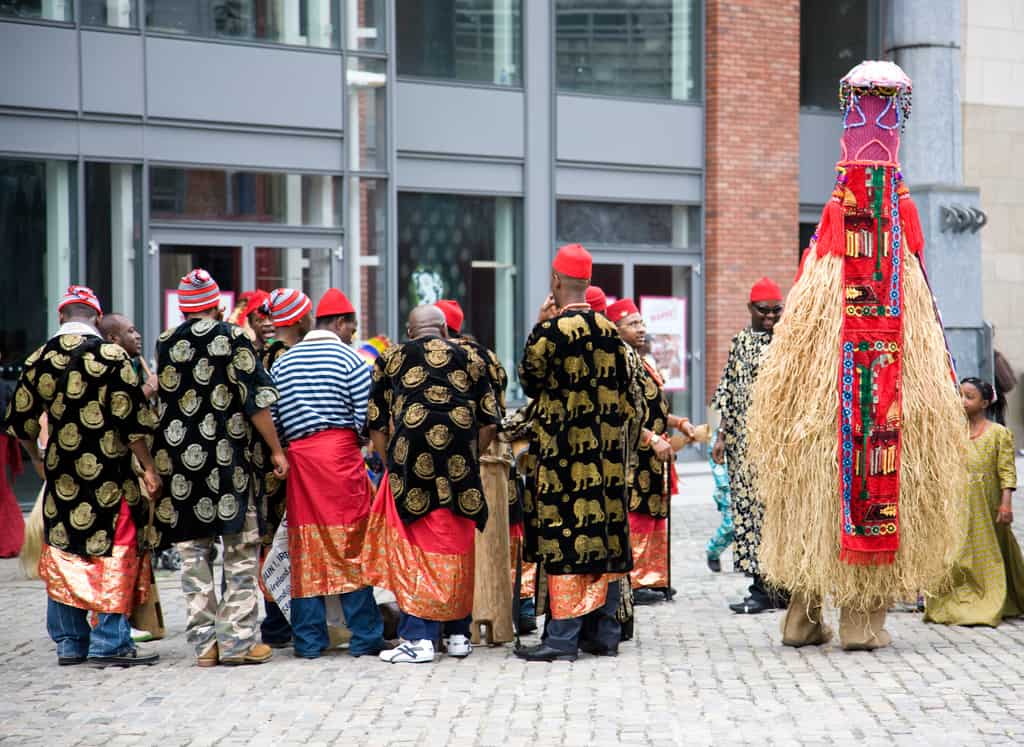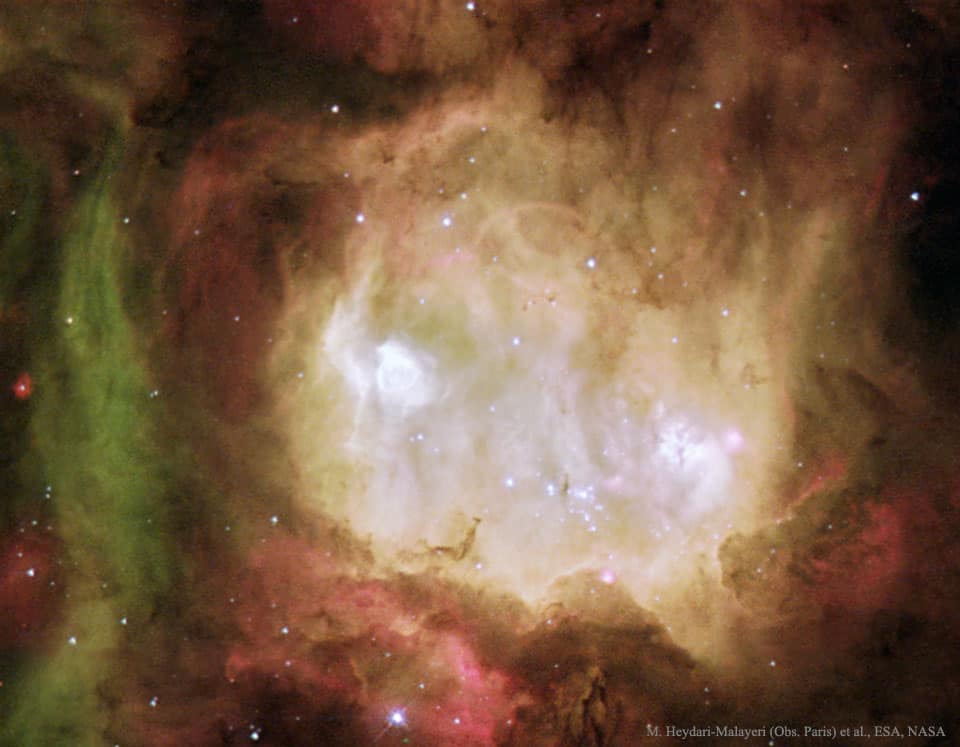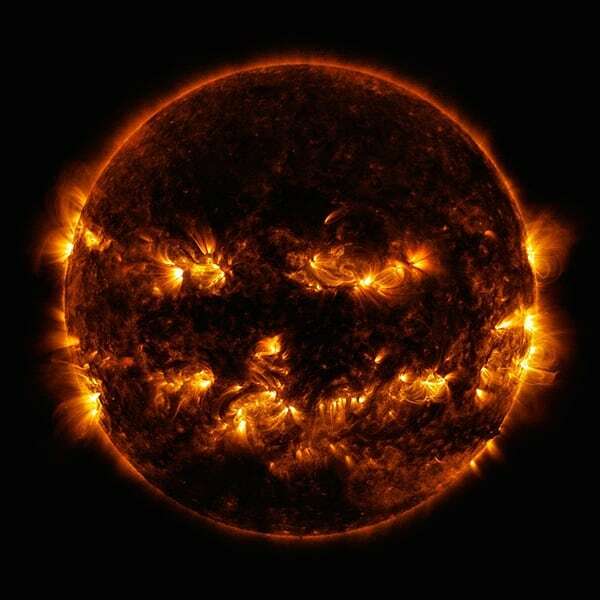HAPPY HALLOWEEN! The Sun is watching you! This image was taken by NASA's Solar Dynamic Observatory in October 2014. The image blends two sets of extreme ultraviolet wavelengths. The active regions of the Sun appear brighter.
Let’s talk about Halloween. Our whole existence, in fact everything alive on this planet is because of that big ball of energy around which we orbit – the Sun. And all our seasons and festivals have their origin in the way the Earth’s orbit around our star brings about different seasons, such as Autumn/ Fall or the end of the harvest season.
What is Halloween?
In Britain, Samhain (pronounced Sew-win or sa-win) is a Gaelic festival that initially used to be celebrated by the ancient Celts (different people who lived around 2,000 years ago in Ireland, Britain, France up to Austria), to mark the end of summer, the end of harvest and the start of the darker half of the year. Cattle were brought down from summer pastures as well. Bonfires were lit. The souls of dead family were also thought to visit. Disguising (guising) or dressing as someone/something else was part of the festival and people went door to door singing in exchange for food. When the Christian church shifted All Hallows/All Saints day (vigil to commemorate the saints) to this time in the seventh century, Samhain & All Hallows traditions merged and we got Halloween. In Samhain, bornfires were traditional sympathetic magic, mimicking the Sun & getting rid of harmful influences. Apple bobbing was a common game. Guising also warded off malevolent visitors from the other world & eventually evolved into playing pranks.

Jack o Lantern made with turnip
The guisers illuminated the night with turnip lanterns (Jack o’lantern), whose grotesque faces were thought to ward off malevolent spirits. Originally, the Irish myth was that a man known as Stingy Jack had tricked the devil and was punished by being compelled to roam the Earth with just a burning coal in a turnip for light. The mass migration of Scottish and Irish people to America in the 19th century, popularised Halloween there. The jack o’ lanterns started being made with pumpkins. And then the Americanised version spread everywhere else. Most of the original Samhain customs became part of Halloween.

A pumpkin jack-o’-lantern, one of the symbols of Halloween
Another very similar festival is Ghost Month, also known as the Hungry Ghost Festival, a traditional festival celebrated in various East and Southeast Asian countries. It is observed on the 15th day of the seventh month of the lunar calendar, which usually falls between August and September. The seventh month is generally regarded as the Ghost Month, in which ghosts and spirits, including those of deceased ancestors, come out from the lower realm (diyu or preta). According to Taoist and Buddhist beliefs, on the fifteenth day of the seventh month, the realms of Heaven and Hell and the realm of the living are open. Both Taoists and Buddhists perform rituals to transmute and absolve the sufferings of the deceased. During this period, it is believed that the gates of hell are open and the spirits of the dead are free to roam the Earth. The festival is marked by ancestor worship, offering food, burning joss paper, chanting of scriptures, and other rituals.
Clearly, the arrival of winter, bringing darker days, has always had an impact on our psyches and rituals.
Harvest Festivals

Roman Goddess Ceres
Harvest festivals have been celebrated all over the world by many cultures since the beginning of agriculture. The end of the harvest season signifies plentiful food, end of toiling in the fields and general merriment. This time is also the portent for winter.
Differences in climate & crops mean harvest festivals can be celebrated at various times at different places. Over the course of history they have evolved into different traditions and customs, like Thanksgiving in North America & mid-Autumn Festival in China. The Yam Festival or Iwa ji is celebrated in west African countries like Nigeria, Ghana and other African countries in August and September by the Ewe and Igbo people, to celebrate the end of rains and first appearance of yams, symbolizing the conclusion of a harvest and the beginning of the next work cycle. The Jewish people celebrate Sukkoth the “Festival of Ingathering at the year’s end”, marking the end of the harvest time. Mehregan was an ancient Zoroastrian tradition practiced in Persia. The Roman celebration of Cerelia was a harvest festival dedicated to the honor of Ceres, their goddess of corn.

Igbos in diaspora celebrating Iwa-Ji in Dublin, Ireland
(Also see Arrival of the Sun Festival)
There are many others. Onam is an annual Hindu harvest festival celebrated in the Indian state of Kerala and Diwali is a post-harvest festival celebrated in South Asia, South-East Asia and other parts of the world by Hindus, Jains, Sikhs and some Buddhists. This five-day celebration, observed every year in early autumn after the conclusion of the summer harvest, is probably a fusion of harvest festivals in ancient India. It is mentioned in Sanskrit texts in the second half of the 1st millennium CE. Diyas or lamps are mentioned in Skanda Kishore Purana, as symbolising parts of the sun, describing it as the cosmic giver of light and energy to all life and which seasonally transitions in the Hindu calendar month of Kartik.

Rangoli, decorations made from colored powder, is popular during Diwali (Wikipedia)
The Egyptians gave thanks to Min and the Greeks to Demeter (Goddess of Agriculture). The mythology around Demeter is tragic and compelling. Demeter was the Greek goddess of the harvest, and Persephone was her beautiful daughter. Hades, the god of the underworld, kidnapped Persephone and took her to the underwold to be his queen. Demeter was heartbroken and refused to let the crops grow until Persephone was returned. Her refusal to allow the crops to grow compelled Zeus, the king of the gods, to make a deal with Hades: Persephone could return to the surface for part of the year, but she had to spend the rest of the year in the underworld. This myth explains the cycle of the seasons: when Persephone is with Demeter, it is spring and summer, and when she is in the underworld, it is autumn and winter.
The Mid-Autumn Harvest Moon Festival is also celebrated in China, Taiwan, Vietnam, and the Philippines. Mooncakess are shared with family and it is also a time of courtship.

Chinese Harvest Moon Festival
Mexico celebrates the Day of the Dead, a holiday traditionally celebrated on November 1 and 2, though other days, such as October 31 or November 6, may be included depending on the locality. The holiday involves gathering of family and friends to honour and remember dead relatives and friends. Even though it may seem like a sombre occasion, the celebrations do take on a humorous tone, as people remember funny events and anecdotes about those that have departed. Similar holidays are also celebrated by the Mexican diaspora and in other Latin American countries like Belize, Bolivia, Brazil, Costa Rica, Ecuador, Guatamala and Peru among others.

Cempasúchil, alfeñiques and papel picado used to decorate an altar during Day of the Dead in Mexico (Wikipedia)
Meanwhile in the Southern Hemisphere, the harvest festivals happen in May/June. The Indonesian Rice Harvest Festival actually happens in May, at the end of the rice harvest. Among other things, small straw dolls are placed in the fields & villages as a tribute to the rice god, Dewi Sri.

Indonesian Rice Harvest Festival (Wikipedia)
In recent years, Halloween has become a major commercial and cultural holiday, with people of all ages enjoying the festivities, from children collecting candy to adults attending costume parties or horror film marathons. And why not, we all need any opportunity to have fun, don’t we?
A time for creativity, community, and a little bit of spookiness, Halloween provides an opportunity for people to express themselves through costumes and decorations and to enjoy the playful, eerie, and sometimes eerie aspects of the holiday.
As far as I am concerned any festival to have a bit of fun is awesome and I will have sweets ready for trick’o’treaters.
Be safe & enjoy. Happy Halloween everyone! Below is the Ghost Head Nebula.

NGC2080 Ghost Head Nebula. Credit: Mohammad Heydari Malayeri Observatoire de Paris et al /ESA/ NASA
Featured image credit: NASA/SDO







